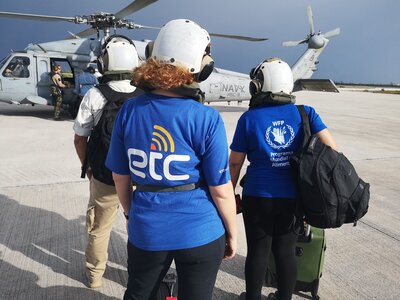Emergency Telecommunications Cluster
- 29 organizations
- from the humanitarian, private and government sectors globally work together to provide shared communications services in emergencies under the Emergency Telecommunications Cluster (ETC)
- Over 40
- humanitarian emergencies responded to by the ETC since its establishment
The 29 partners of the World Food Programme (WFP)-led Emergency Telecommunications Cluster (ETC) are on hand within 48 hours to work with local partners and reconnect communities, responding to up to 10 emergencies per year.
In the minutes, days and weeks after a cyclone, earthquake or tsunami, or during armed conflict, actors at all levels require communications connectivity: from the individuals and families affected, to governments who lead and coordinate national relief efforts and the humanitarian organizations who contribute to local response.
From Afghanistan and Iraq, to Haiti, the Philippines and Nepal, for over 15 years the ETC has provided timely, predictable and effective telecommunications services to humanitarians responding to crises.
Examples of ETC services and activities
-
Voice connectivity (telephony)
-
The ETC offers voice communication options for all three of its main users: humanitarian organisations, national and local authorities, and the affected population.
-
Internet connectivity
-
The ETC provides the technology and infrastructure that is lacking in emergency situations to improve the accessibility, affordability and usability of information and communication tools in both sudden-onset and protracted crises.
-
Local broadcaster support
-
Helping local radio stations get back on the air after a disaster is one of the most effective ways to reach communities in crisis.
-
Two-way communication between humanitarians and affected communities
-
Allows people in crisis to express their needs and concerns to humanitarians in a timely manner.
-
Security communications systems
-
Essential to humanitarian operations, not only as a security mitigation measure, but as a backup system to use after sudden onset emergencies.
-
Training, simulations, and e-learning
-
Rigorous training opportunities targeting different skill sets meet the capacity building needs of humanitarians so they can keep pace with evolving technologies. Simulation exercises reinforce emergency technology skills by putting participants in real-world-like situations.
-
Localized and global preparedness activities
-
When preparedness measures are in place, first responders save more than a week of time in an operation; the ETC works with national and local government agencies, civil society groups, humanitarian organizations, the private sector, and local communities on emergency telecommunications readiness.
Related topics
Engage with the Emergency Telecommunications Cluster


